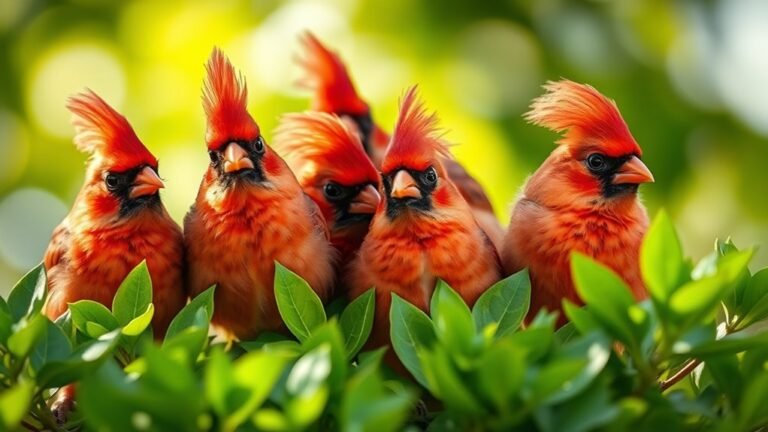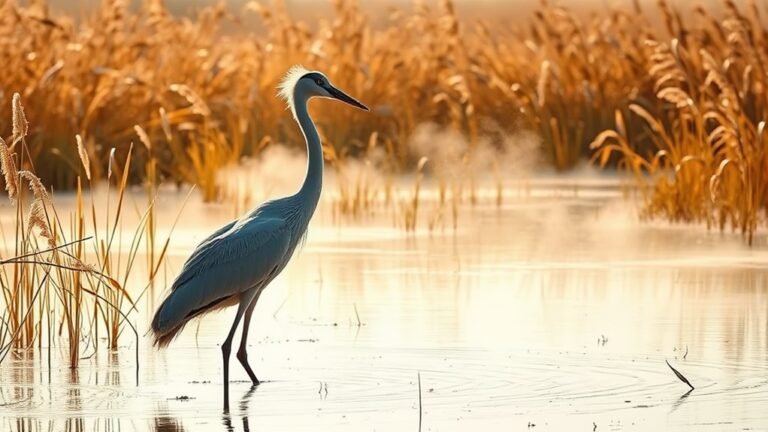Black Birds in North Carolina: Sleek and Mysterious Flyers
In North Carolina, black birds like the Common Grackle and Red-winged Blackbird show beauty and adaptability. Their shiny feathers attract attention. Their social behavior engages many observers. These birds thrive in different environments and impact ecosystems and human views. As you explore where they live, think about their roles and the challenges they encounter. What factors influence their lives in this diverse environment?
Key Takeaways
Black birds, like the Common Grackle and Red-winged Blackbird, play an important role in North Carolina's ecosystems. They help support biodiversity and maintain habitats. Their shiny feathers and unique behaviors attract birdwatchers and nature lovers in the area.
Many black bird species migrate and return in spring to breed. This shows their ability to adapt to North Carolina's changing environments. However, habitat loss from urbanization and climate change poses serious threats to these birds. This situation emphasizes the need for conservation efforts.
Watching black birds in wetlands and open fields allows people to connect with North Carolina's diverse wildlife. Enjoying this experience can deepen appreciation for nature and the vital role these birds play in the ecosystem.
Overview of Black Birds in North Carolina

In North Carolina, black birds such as the Common Grackle and the Red-winged Blackbird are important to the local ecosystem. These birds have shiny feathers, long tails, and friendly behaviors.
Their bold appearance stands out against the natural scenery, making birdwatching enjoyable.
Many black birds migrate to warmer areas during the winter and return in the spring to breed. Watching their arrival and behaviors helps you learn about local wildlife and ecology.
This connection to nature builds community among birdwatchers and highlights the importance of protecting habitats and wildlife.
Common Grackle: The Social Bird
The Common Grackle is a black bird commonly seen in North Carolina. It's noted for its shiny appearance and social behavior.
These birds live in groups, showing interesting flock dynamics. In their gatherings, you can see them communicating through different calls, making it a lively experience. Flocking together helps them stay safe and find food more easily.
This behavior creates a sense of community, with hierarchies and relationships forming among the birds. By watching their interactions, you can appreciate the social life of the Common Grackle, making your encounters enjoyable and meaningful.
Red-winged Blackbird: The Marsh Dweller

In the wetlands of North Carolina, the Red-winged Blackbird is an important marsh bird. This bird prefers marshes filled with reeds and cattails. Its striking red and orange shoulder patches contrast with its black feathers, making it easy to spot.
During breeding season, male Red-winged Blackbirds display their territory by singing loudly and clearly. This song serves two purposes: it asserts their dominance and attracts females.
Understanding their behavior helps you connect with the local ecosystem and appreciate the diverse wildlife of North Carolina.
Brown-headed Cowbird: The Brood Parasite
Brown-headed Cowbirds have a unique reproductive strategy that impacts local bird populations. They lay their eggs in the nests of other bird species. This brood parasitism means that host birds often raise cowbird chicks instead of their own. This behavior can affect population sizes, as cowbird chicks may compete with the host's fledglings for food and resources.
Brown-headed Cowbirds can adapt to various environments and find available nests to exploit. Observing their behavior helps us understand interactions between bird species.
This also highlights the delicate balance of ecosystems, particularly in North Carolina. By learning about cowbirds, we gain insight into the dynamics of nature and the challenges faced by other bird species.
European Starling: The Introduced Species

European Starlings are birds known for their shiny feathers and social habits. They were brought to North Carolina from Europe in the 19th century to enrich the bird population. However, they've become an invasive species.
Starlings compete for food and space, pushing out native birds. Their large flocks can also damage crops in agricultural areas.
Understanding the impact of European Starlings helps us see the importance of protecting native species. These native birds play a key role in keeping ecosystems balanced and diverse.
Taking care of our local environment is crucial for maintaining this biodiversity.
Black-crowned Night-Heron: The Nocturnal Fisher
The Black-crowned Night-Heron is a native bird found in North Carolina's wetlands. This bird hunts at night, making it different from many others.
You can see it in the evening, where it uses its good eyesight to find food. The heron has a clever way of fishing; it stands still and waits for fish, frogs, or insects to come close. When it sees its prey, it strikes quickly, showing great skill.
This bird is important to the local ecosystem because of its unique hunting methods and adaptability. Watching these fascinating birds can help you appreciate North Carolina's natural beauty and connect you with the area's wildlife.
American Robin: The Familiar Visitor
When spring arrives in North Carolina, the American Robin appears in backyards, signaling the season's change. This bird stands out with its bright orange breast and cheerful song. As temperatures rise, robins return from their winter homes. Their presence marks the beginning of spring.
You can often see them searching for worms and berries on the ground. Watching robins can deepen your connection to nature and remind you of seasonal changes.
Their ability to thrive in urban areas adds to their charm, making them a beloved part of the North Carolina environment.
Common Raven: The Intelligent Scavenger
As you look up at the skies of North Carolina, you may see the Common Raven flying high. These birds are smart and adaptable. They play a key role in the ecosystem as scavengers. You'll often notice them searching for food with sharp eyesight and using clever problem-solving skills.
- Ravens can use tools to get food.
- They communicate with various calls and gestures.
- They often work in pairs and have strong social connections.
- Their ability to adapt helps them thrive in different environments.
Learning about the Common Raven helps you appreciate these fascinating birds and their important role in nature.
Great-tailed Grackle: The Bold Performer
The Great-tailed Grackle stands out in North Carolina.
During mating season, male grackles show their impressive glossy feathers. They call loudly and display their bodies, showing confidence and marking their territory.
These birds prefer open spaces like parks, fields, and wetlands. They eat insects, seeds, and leftover food. Their ability to adapt helps them thrive in urban areas, where you can often spot them.
Watching the Great-tailed Grackle enhances your time outdoors and connects you with the rich birdlife in your area.
Fish Crow: The Coastal Forager
Fish Crows are commonly seen in North Carolina's coastal areas. Their foraging habits make them interesting birds to observe.
- They search for food scraps left by beach visitors.
- Fish Crows catch small fish and crustaceans by diving.
- Their unique calls distinguish them from other crows.
- They help in seed dispersal, playing a key role in the coastal ecosystem.
These behaviors highlight how Fish Crows adapt and thrive in their environment. Observing them can be both enjoyable and insightful.
Subtle Beauty of the Common Blackbird
The coastal environment supports Fish Crows and another interesting bird: the Common Blackbird.
These birds have striking black feathers that shine with hints of blue and green in the sunlight. They often forage in groups, showing their friendly and adaptable nature.
In many cultures, blackbirds symbolize transformation and mystery, linking them to deeper meanings. Recognizing these traits helps you appreciate their role in the ecosystem.
Observing their subtle beauty connects you to the rich tapestry of nature in North Carolina.
The Role of Black Birds in the Ecosystem
Black birds, such as Fish Crows and Common Blackbirds, play vital roles in North Carolina's ecosystem. They indicate the health of habitats and help maintain ecological balance as key species.
Here are their main environmental contributions:
- They disperse seeds, promoting plant diversity.
- Their feeding helps control insect populations.
- They provide food for larger birds and mammals.
- They scavenge, recycling nutrients back into the soil.
These birds thrive in various environments, from urban areas to wetlands, making them significant to their habitats.
Challenges Facing Black Birds in North Carolina
Black birds are important to North Carolina's ecosystem, but they face many challenges that threaten their numbers and homes.
One major problem is habitat loss due to urban development and agriculture. As people build more roads and buildings, black birds lose places to nest and find food.
Climate change adds to these problems by changing habitats and food sources. Warmer temperatures and new weather patterns can disrupt migration and breeding, making survival more difficult for black birds.
By understanding these issues, you can appreciate the beauty of these often-overlooked species even more.
Supporting conservation efforts can help ensure that black birds remain part of North Carolina's landscape for the future.
Birdwatching Tips: Spotting Black Birds
Where are the best spots to observe black birds in North Carolina?
First, gather your birdwatching equipment, including binoculars and a field guide.
Then, visit these ideal locations:
- Wetlands: Look for grackles and cowbirds near water.
- Open Fields: Watch for red-winged blackbirds on tall grasses.
- Forested Areas: Listen for the calls of different blackbird species.
- Parks and Backyards: Keep your feeders stocked to attract blackbirds.
Be patient and observant. Spotting these black birds takes time and practice.
Connect with other birdwatchers to share tips and enjoy North Carolina's birdwatching opportunities together.
Conservation Efforts for Black Bird Populations
Black bird species in North Carolina face threats that impact their populations. Targeted conservation efforts are needed. Habitat preservation is crucial for protecting the ecosystems these birds need.
You can get involved by joining local projects that restore wetlands, forests, and grasslands. These areas provide essential nesting and feeding sites.
Population monitoring is also important. You can help by participating in citizen science programs and reporting your bird sightings. This information helps researchers track bird trends and create protections.
Joining community groups is a great way to connect with others who care about black birds. Your involvement can make a difference. Together, these actions support the health and survival of black bird populations, allowing these fascinating birds to continue flying in our skies.
Frequently Asked Questions
What Are the Best Places to Observe Black Birds in North Carolina?
To observe black birds in North Carolina, visit popular birding locations like the Outer Banks and wildlife refuges. Parks in urban areas also provide good opportunities for bird watching. These diverse environments support many species of black birds. Enjoy the beauty of nature as you spot these fascinating birds in their habitats.
How Can I Distinguish Between Similar Black Bird Species?
To distinguish between similar black bird species, watch for key features like wing shape, eye color, and size. These characteristics can help you identify each bird. Also, listen to their calls; each species has unique sounds that make identification easier and more enjoyable.
What Is the Migratory Behavior of Black Birds in NC?
Black birds in North Carolina show clear migratory behavior. They travel in groups, aiming for warmer areas or food. Their routes change with the seasons and local conditions. Observing these patterns can provide insight into their migration. This behavior is common among many black bird species in the region. Understanding their movement helps us appreciate their role in the ecosystem.
Are Black Birds Harmful to Gardens or Crops?
Black birds can help your garden by controlling insect populations. They protect your crops from pests. While they may eat some seeds, their benefits usually outweigh any small damage they cause. Enjoy the presence of these birds as they work to keep your garden healthy!
What Time of Year Is Best for Black Bird Watching?
Spring migration is the best time for watching blackbirds. During this season, they search for feeding grounds. This behavior lets you see their interactions and vibrant activities as they move and gather. Enjoy the excitement of observing these remarkable birds during migration.

Ava is a bird enthusiast and nature lover who has spent countless hours observing and learning about the fascinating world of birds. With a passion for sharing her knowledge and inspiring others to appreciate the beauty of birds, Ava writes about her experiences and insights on avianadmirer.com.







